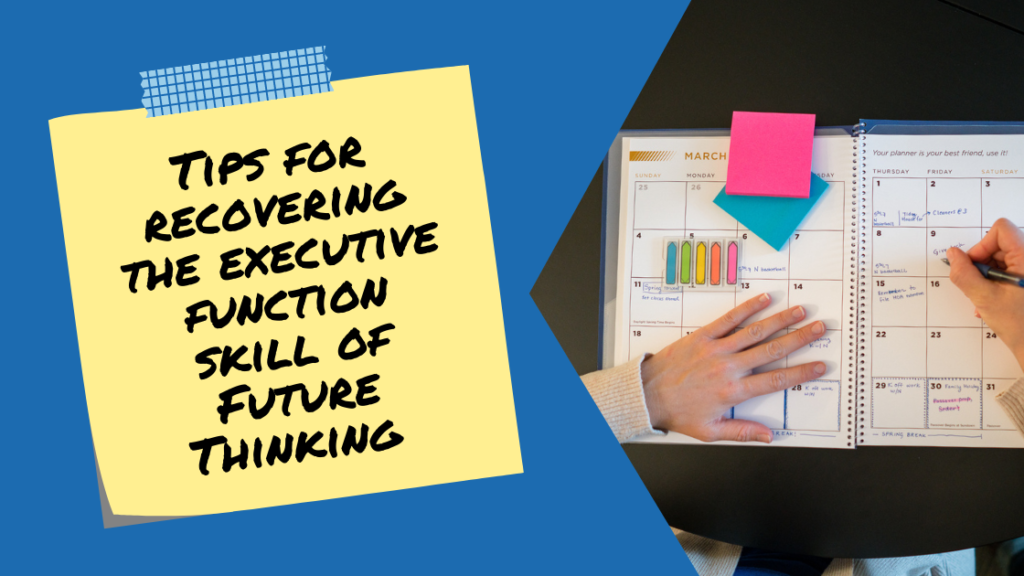As part of my online training course for professionals, the Teaching the Seeing My Time Program, I offer two live Q&A sessions. I love this opportunity to address participants’ questions about teaching executive function skills. But at a recent live Q&A, a course participant asked a question that froze my brain: “With COVID19’s impacts on everyone’s daily routine, what executive function challenges do you forecast will be most pressing/challenging as we begin returning to our in-person lives?”
For a moment, all I could think was: “There is going to be a post-COVID time?” For a few seconds, I couldn’t imagine that possibility in order to answer the question. Then my brain kicked into gear and the answer came quickly. The challenge in returning to in-person learning will be to jump-start the executive function of future thinking.
For over an entire year, the executive skills of planning and prioritization, aspects of future thinking, have taken a back seat to the demands of daily survival in a highly unpredictable world. Planning and goal setting have been very difficult, if not impossible, to implement. Even for me, the goal pages of my 2021 Seeing My Time planner were empty through March. I wrote vacation dates (not plans) lightly in pencil. Who knew what could or would really happen?
Thankfully, spring is here and many of us have gotten one, or both, of our COVID vaccinations. It’s time to pick that future thinking back up and begin – tentatively – to plan. Here are some great pointers for anyone who feels rusty with this practice.
Quick Strategies to Support the Executive Function of Future Thinking
- Break it down. For multi-step projects, note the final due date in your calendar or planner. Then schedule in the smaller steps needed to reach that goal. Breaking tasks down into smaller steps is key for planning and prioritizing.
- Use your tools. If you have been lax in using your external time tools like timers, analog clocks and sticky notes during the pandemic, now is a good time to return to those to support your brain!
- Recommit to your calendar. If anything comes up to disrupt your goal or scheduled tasks, update your calendar right away. Keep it in sight at all times.
- Give yourself a time buffer. We’ve all gotten used to virtual appointments, but with some things returning to live events, it’s important to include drive time for getting to and from those appointments. It takes time to get yourself ready to leave the house (pajamas may no longer be acceptable streetwear). Driving takes time and the traffic is getting heavier again. You don’t want to be late!
- Estimate time needed. Note how long things will take on your to-do list items, to give a more realistic view of the time needed for each task.
- Write it down. Fill out your day, week and month forms in the Seeing My Time planner, and add your projects to your calendar. Writing things down and getting them out of your head and onto paper will help to solidify them.
- Be kind to yourself! We’ve all been through a tough year. If something you planned doesn’t work, remind yourself that we are all adjusting. Reward yourself for things you do accomplish!
Moving Forward into the Future
When it comes to my own future thinking, I have started writing down my goals in my planner. I am making plans to visit my daughter after she moves to California from DC. And most incredibly, I am planning my son’s 36th birthday party in my home. He loves rhubarb so here’s the pastry I shall make. What a joy to be able to plan and share food with my circle of loved ones!!!!
So, my friends, as your world begins to open up more, remember to support your brain’s planning and prioritization executive skills. Get out your planner and write some short-term goals. Break those goals into smaller doable steps. Put the steps into your monthly and weekly calendar pages. Transfer some of those steps to your day plan. This is putting into practice the term “little by little.” Future thinking is about breaking things down into small steps, taking action, and rewarding ourselves for the work. You’ve got this!
Little by little…
Marydee


Would love to learn about your services for teens.
Thanking you